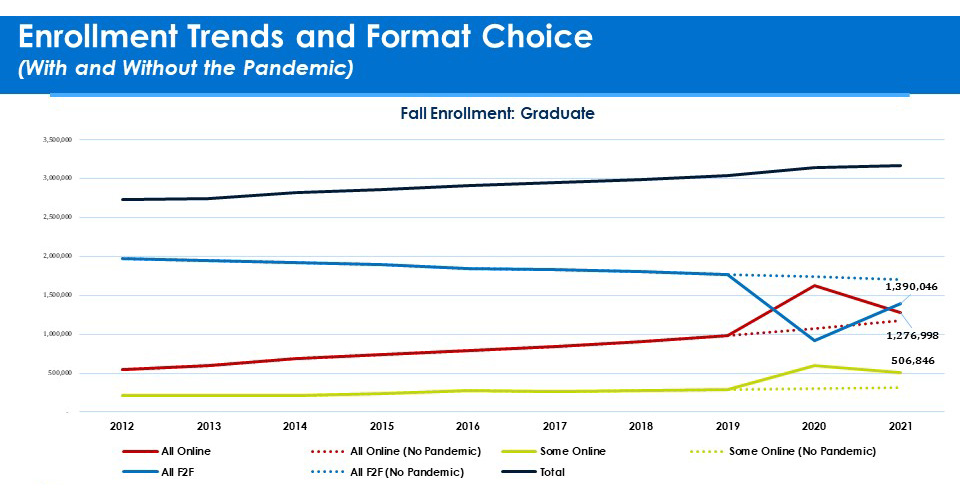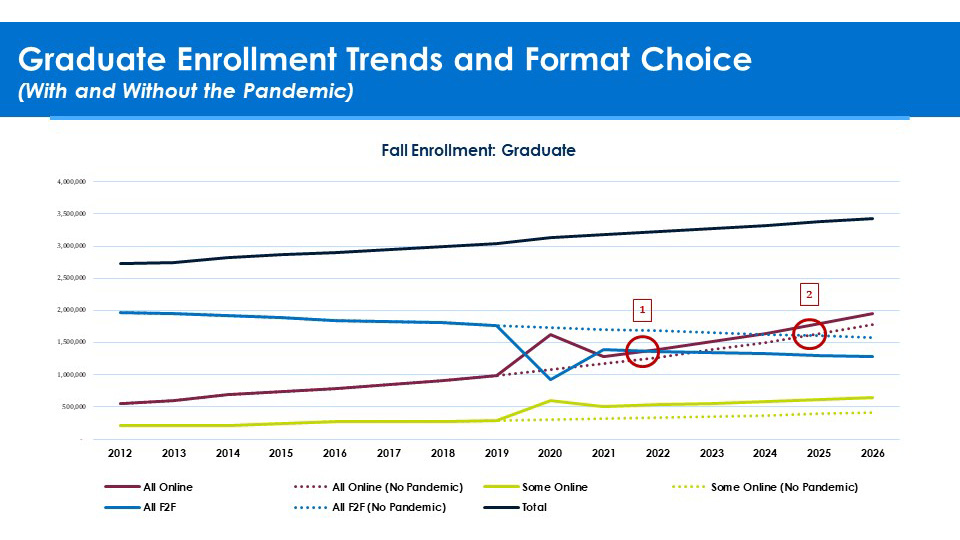enrollment
Projecting Graduate Enrollment by Format
What is the long term impact of the pandemic on graduate enrollment? This is the question I am most frequently asked. I wanted to hold off providing an answer until we have the 2021 academic year data, knowing that the real answer will only come with a few more years of enrollment trend data.
Given the fact that millions of students were forced into online (or emergency remote) instruction, the most important issue will likely be the instructional format choices of graduate students. With almost all graduate students now having some experience with online instruction, the big unknown is what I call “the Mikey Affect” (after the famous Life cereal commercial): the proportion of students who, having tried online education, liked it enough to continue with it.
With the fall 2021 enrollment data, we began to see the extent of the “rebound” back to fully classroom study. The visualization below displays All F2F (face-to-face) classroom enrollment (blue), All Online (red), and Some Online who enrolled in some online and some classroom courses (green). We’ve added dotted lines that used the 2012-2019 compound annual growth rate (CAGR) to project a “No Pandemic” view. The “real” data make it clear that while “All F2F” again overtook “All Online” is did not reclaim its full “pre-pandemic” market share.

Source: RNL Analysis of IPEDS Fall Enrollment Snapshot data. (U.S. degree-granting institutions of at least two years.)
In fact, if you compare 2019 with 2021, 374,000 fewer students selected All F2F, 289,000 more selected All Online, and more 215,000 more selected Some Online courses. All F2F led in 2021 by just 113,000 students compared with 776,000 in 2019. While we do not yet know exactly what is in store in the future, it is clear that graduate students did not flock back to classroom study once they had the opportunity to do so. This is particularly important when you note that year over year graduate enrollment grew by 2.4 percent between 2020 and 2021.
Projecting what comes next for graduate enrollment using three assumptions
But how can we begin to understand what is likely coming in the near future? When will online students overtake classroom? What will happen with the Some Online students (a version of hybrid/blended study that so many institutions think may be their way forward in the face of resistance to fully online programs)? I decided to take a stab at some high level projections predicated on a set of assumptions:
- Let’s see the 2021 data as a solid indicator of a change in preference, and therefore as a new starting point for the future.
- We do not yet have enough data to include a mathematically calculated “Mikey Affect” (the portion of the graduate population that previously chose classroom but now chooses online).
- Post-pandemic rates of growth (or contraction) by format are unlikely to be any less than they were prior to the pandemic.
With 2021 as our new starting point, and relying on Assumption 3, we used the pre-pandemic annual growth rates (CAGR) data from 2012 to 2019 to project into the future to see where those who choose All Online will surpass those who choose All F2F. This visualization showcases both where the new projections would see that happen (1) and when it would have happened with no pandemic (2).

Source: RNL Analysis of IPEDS Fall Enrollment Snapshot data. (U.S. degree-granting institutions of at least two years.)
Using our three assumptions, demand for all online study will surpass all classroom in 2022 (we only have a few months to wait until the 2022 IPEDS data will prove if this is the case). Perhaps more importantly, graduate programs only had until 2025 for this to happen without the impact of the pandemic. (Incidentally, 2025 is the year that has been targeted as the first year that the much considered “demographic drought” is going to impact traditional undergraduate enrollment.) We may see in the 2022 data that we are not quite there yet, but it almost certain that it is only a matter of time.
The clearest takeaway of these projections is that institutions that want to grow or maintain enrollment in the face of the oncoming demographic drought have to not just focus on graduate program growth, but must ensure that the program areas in highest demand (business, nursing, social work, to name a few) are available in an online format that meets student needs.
We will cover this in more detail in RNL’s second national study of the graduate market, based on a survey of more than 1,500 prospective and enrolled graduate students. We are already putting these data to work for our clients and partners, and we can share our insights with you now as well. Schedule a complimentary consultation today to talk through how our findings align with your current practices and plans for the future.
Talk with our graduate and online enrollment experts
Ask for a free consultation with us. We’ll help you assess your market and develop the optimal strategies for your prospective graduate students and online learners.
